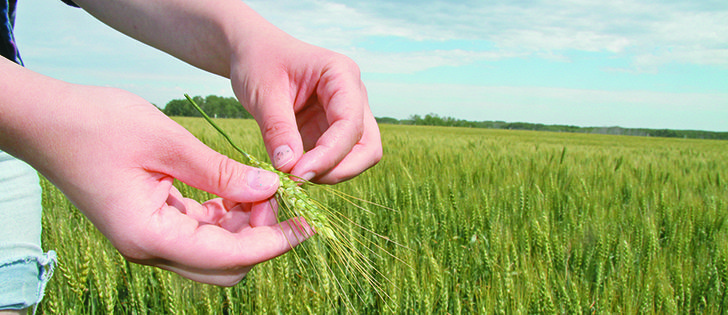Market analysts say Alberta Wheat Commission’s website will add to an already large amount of industry information
Grain growers will have vastly im-proved market transparency when selling the 2015 crop.
The Alberta Wheat Commission is putting the finishing touches on a website at www.pdqinfo.ca that will provide farmers with regional average daily cash prices for all the major crops.
“We’re hoping to be able to make some announcement closer to harvest,” said general manager Tom Steve.
The commission and Farmers Advanced Risk Management Co., a grain marketing consulting firm that is leading the project, initiated discussions with grain companies this spring about gaining access to their daily elevator bids.
Read Also

Critical growing season is ahead for soybeans
What the weather turns out to be in the United States is going to have a significant impact on Canadian producers’ prices
“We have had very fruitful discussions with all of the major grain companies and some of the smaller ones as well,” said Steve.
The only thing holding up the launch are technical issues that need to be ironed out.
Steve said the website will contain average prices for all the major crops in eight zones across Western Canada.
“We’re trying to reflect an average regional price, but we’re not sharing any proprietary information,” he said. “We think it’s a major step forward to have access to that timely information.”
Chuck Penner, analyst with LeftField Commodity Research, said grain pricing and movement information is already more transparent than many farmers believe.
Agriculture Canada publishes a weekly report containing a lot of pricing information, while provincial agriculture departments, ICE Futures Canada and grain companies and stand-alone inland terminals also publish prices daily or weekly.
“This is market transparency,” he told the Agricultural Producers Association of Saskatchewan’s recent mid-term convention. “Not great, but it’s market transparency.”
However, only a couple of farmers raised their hands when he asked the audience how many make use of those resources. Growers can also find out basis prices if they know where to look.
ICE publishes a canola basis comparing Vancouver port prices to futures prices, and Penner compiles his own elevator basis charts for Western Canada and North Dakota based on publicly available information from grain companies.
“In my mind, that’s transparency,” he said.
There is also port-to-futures basis information for No. 1, 13 percent Canada Western Amber Durum at the West Coast and at St. Lawrence, and Penner said he is able to compare those levels against the average Canadian prairie basis.
As well, the Canadian Grain Commission publishes a wealth of information on grain logistics every week.
“That’s helpful information,” said Penner. “Some of it is more useful than others.”
The Ag Transport Coalition also provides timely information detailing railway performance on a weekly basis.
One thing that is missing is reporting of export sales. In the United States, exporters are required to provide weekly updates about what crops they shipped and where they went. The information is compiled and published by the U.S. Department of Agriculture’s Foreign Agricultural Service.
“We don’t have that. That’s one of the things we need,” he said.
Penner also laments the loss of the weekly vessel line-up report, which disappeared when the Canadian Ports Clearance Association closed its grain transportation business in 2012.
He used to be able to look at the report and see, for example, that six vessels were waiting to be loaded with 240,000 tonnes of peas. Through CGC reports he could see how much was in port terminals and country elevators and assess whether grain companies would need to adjust pea prices to attract quick deliveries from farmers. It was a good barometer of where prices were heading.
“That is one of my big beefs because that’s (how) I would give some of my best advice,” he said.
Steve said the commission will attempt to fill those information voids in future versions of its website.
“Definitely we’re looking at all of those issues, and I would concur with (Penner’s) assessment,” he said.
Penner said growers need to start using the available price and logistics tools if they want to maintain the market transparency that exists today.
He has had conversations with Agriculture Canada officials who have threatened to stop posting weekly prices because of poor use of the service.
“If nobody uses it, of course they will disappear,” said Penner.
Growers should also put pressure on grain companies to list more pricing information on their websites. Some don’t publish prices at all.
“It doesn’t help to complain to your local guy,” he said. “You really have to go up the food chain to talk to the guys as high up as you possibly can.”
Penner would also like farmers to request more information from the grain commission.
“I know the guys who work in that stats department. They would love to do more for you guys. They would absolutely love to,” he said.
The problem is a lack of resources, but farmers clamouring for information would be hard to ignore.
Growers can also lobby members of Parliament for more market transparency, but they need to be specific about what they want.
“It’s one of these things like world peace. Yeah, that’s a great idea, but what do you mean by that? What parts are missing? What don’t we have now that we would like to have?”
He said grain companies, railways and groups such as Quorum Corp. have lots of information that they keep under wraps.
“The great unwashed like me don’t get access to that,” said Penner.
“That needs to be made public as well too on a very timely basis.”
He also warned farmers against fudging yield and acreage numbers when Statistics Canada comes calling because the information it compiles is also a form of market transparency.
“If you give them good answers, you have better market transparency. Just saying.”


















